- Arms
- Arm formula: III>II>IV>I.
- Arms III much more robust than arms II.
- Trabeculate protective membranes present on suckered portions of all arms.
- Arm sucker (midportion of arms) rings with 9-12 sharp teeth distally, bluntly pointed teeth proximally.
- Tentacles
- Tentacular club with suckers on carpus in 4 series, suckers on dactylus and manus small and in 4 series.
- Head
- Beaks. Lower beak with thick lateral wall ridge.
- Radula. Radula homodont, marginal plates absent.
- Fins and tail
- Fins sagittate with short tail.
- Photophores
- Arm II with 9 photophores in proximal third.
- Arm III with 19 photophores in proximal two thirds.
- Tentacle with 2 photophores.
- Head with 4 pairs of photophores: One member at base of arm III, one at anterior and posterior edges of eyelid, one on dorsolateral head at posterior margin.
- Eye with 5 photophores in ventral series; middle photophore largest.
- Dorsal mantle anterior to fins with 5 pairs of photophores.
- Dorsal fin with 3 pairs of photophores.
- Dorsal surface near base of tail with large embedded photophore in midline beneath a dorsal window and surrounded by three small photophores at the periphery of the window.
- Dorsal tail with a series of five photophores in midline, termining at apex of tail.
- Ventral surface of mantle with 6 pairs of photophores near or along lateral margins, one unpaired midline photophore near base of tail (ventral to large dorsal photophore).
- Tail with a pair of lateral photophores (in addition to the dorsal series).
- Ventral viscera (within mantle cavity) with a pair of anal photophores, 3 abdominal photophores, 2 elongate gill photophores and 3 posteroabdominal photophores.
- All visceral photophores, except anal photophores, connected by strips of tissue (see figure).
- Gladius
- Viscera
- Male secondary reproductive structures unpaired (i.e. single male genitalia).
- Measurements
UMML - University of Miami Marine LaboratoryMantle length 58.2 65.0 69.7 87.5 Sex Immat. male Immat. male Immat. male Immat. male Status Paratype Paratype Paratype Holotype Respository UMML31.3144 UMML31.3144 UMML31.3143 USNM 817596 Mantle width index 35.4 37.2 37.3 26.0 Head length index 23.2 18.9 18.2 16.8 Head width index 22.9 22.0 18.5 23.7 Eye diameter index 18.9 20.0 21.5 18.3 Fin length index 36.4 38.8 33.9 36.3 Fin width index 96.6 79.7 87.5 74.7 Arm I, length index 59.3 41.5 41.6 30.3 Arm II, length index 119.8 80.3 81.8 88+ Arm III, length index 191.9 111+ 172.9 171.4 Arm IV, length index 49.7 45.9 42.6 38.9 Tentacle length index -- -- -- 125.7 Club length index -- -- -- 22.4 Gladius length index 96.4 86.2 84.7 74.3 Gladius width index 11.5 7.7 7.9 4.9 Rhachis width index 6.2 5.1 4.6 3.9
NMNH - United States National Museum of Natural History
Index - Measurement as a percent of the mantle length
Figure. N. venezuelensis, holotype. Left - Lateral view of arm crown showing the relative thickness of arms II and III. Circular photophores can be seen on the base of arm III. Photograph by R. Young. Right - Large sucker from basal portion of arm IV. Drawing from Arocha (2003).
Figure. Side views of upper (left) and lower (right) beaks of N. venezuelensis, paratype, 69.7 mm ML. Drawings from Arocha (2003).
Figure. Radula (one side) of N. venezuelensis, paratype, 69.7 mm ML. Drawing modified from Arocha (2003).
Figure. N. venezuelensis, holotype. Left - Dorsal view of head, arms and tentacle showing photophore (blue) arrangement. Right - Lateral view of eyeball showing ocular photophores. Drawings modified from Arocha (2003).
Figure. Views near the tail base in N. venezuelensis, holotype. Left - Dorsal view showing the window overlying the embedded photophore. Only the anterior of the three photophores surrounding the window can be clearly seen in the photograph. Right - Ventral view showing the embedded photophore which was apparently cut when the gladius was removed. Photographs by R. Young.
Figure. Mantle, fins and tail of N. venezuelensis showing arrangement of photophores (blue), holotype. Left - Dorsal view. Middle - Ventral view. Right - Ventral view of visceral photophores within the mantle cavity. Drawings modified from Arocha (2003).
Figure. Gladius of N. venezuelensis, holotype. Top - Cross-sections. Middle - Dorsal view. Bottom - Side view. Drawings from Arocha (2003).
Comments
The above description is from Arocha (2003). The number of photophores in the drawing of the arms differs slightly from the number mentioned in the text.

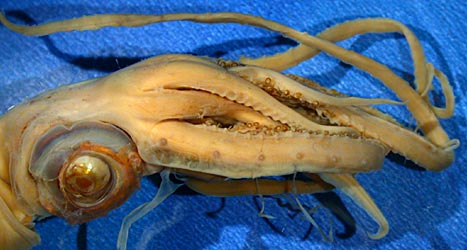
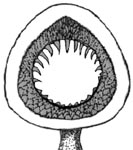
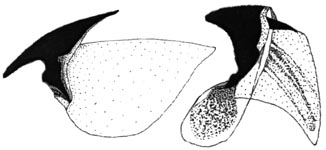
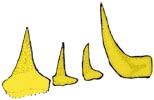
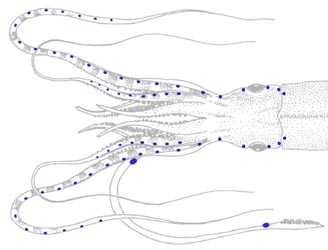
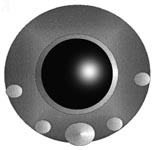
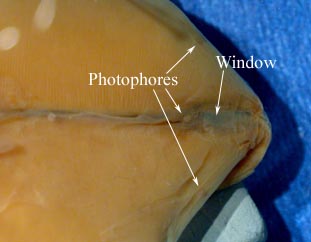
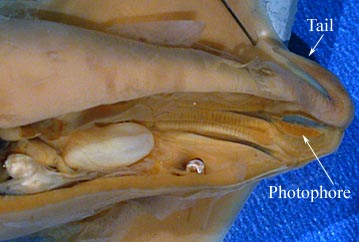
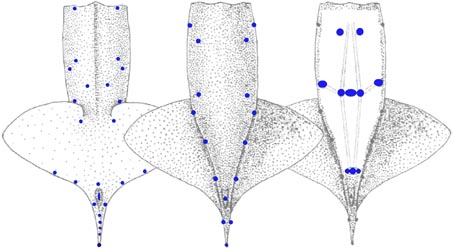





 Go to quick links
Go to quick search
Go to navigation for this section of the ToL site
Go to detailed links for the ToL site
Go to quick links
Go to quick search
Go to navigation for this section of the ToL site
Go to detailed links for the ToL site